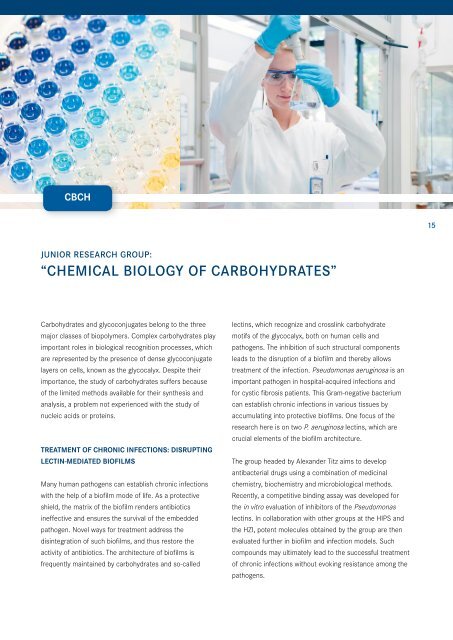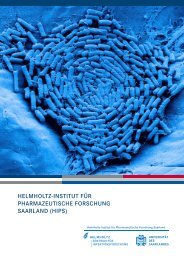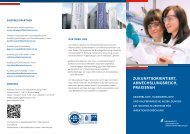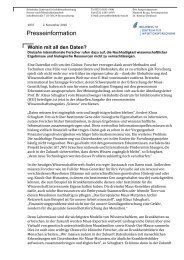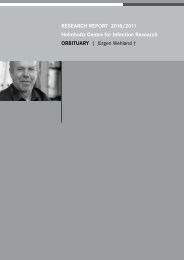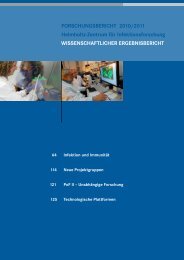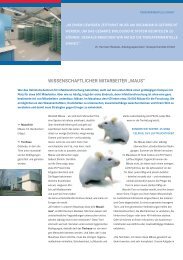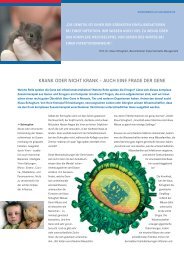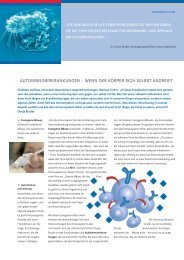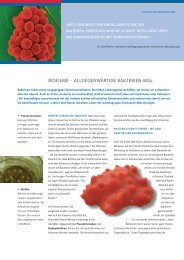hIPs - Helmholtz-Zentrum für Infektionsforschung
hIPs - Helmholtz-Zentrum für Infektionsforschung
hIPs - Helmholtz-Zentrum für Infektionsforschung
You also want an ePaper? Increase the reach of your titles
YUMPU automatically turns print PDFs into web optimized ePapers that Google loves.
cbch<br />
15<br />
JunIor research GrouP:<br />
“chemIcal BIoloGY of carBohYdraTes”<br />
Carbohydrates and glycoconjugates belong to the three<br />
major classes of biopolymers. Complex carbohydrates play<br />
important roles in biological recognition processes, which<br />
are represented by the presence of dense glycoconjugate<br />
layers on cells, known as the glycocalyx. Despite their<br />
importance, the study of carbohydrates suffers because<br />
of the limited methods available for their synthesis and<br />
analysis, a problem not experienced with the study of<br />
nucleic acids or proteins.<br />
treatment Of chrOnic infectiOns: disrupting<br />
lectin-mediated biOfilms<br />
Many human pathogens can establish chronic infections<br />
with the help of a biofilm mode of life. As a protective<br />
shield, the matrix of the biofilm renders antibiotics<br />
ineffective and ensures the survival of the embedded<br />
pathogen. Novel ways for treatment address the<br />
disintegration of such biofilms, and thus restore the<br />
activity of antibiotics. The architecture of biofilms is<br />
frequently maintained by carbohydrates and so-called<br />
lectins, which recognize and crosslink carbohydrate<br />
motifs of the glycocalyx, both on human cells and<br />
pathogens. The inhibition of such structural components<br />
leads to the disruption of a biofilm and thereby allows<br />
treatment of the infection. Pseudomonas aeruginosa is an<br />
important pathogen in hospital-acquired infections and<br />
for cystic fibrosis patients. This Gram-negative bacterium<br />
can establish chronic infections in various tissues by<br />
accumulating into protective biofilms. One focus of the<br />
research here is on two P. aeruginosa lectins, which are<br />
crucial elements of the biofilm architecture.<br />
The group headed by Alexander Titz aims to develop<br />
antibacterial drugs using a combination of medicinal<br />
chemistry, biochemistry and microbiological methods.<br />
Recently, a competitive binding assay was developed for<br />
the in vitro evaluation of inhibitors of the Pseudomonas<br />
lectins. In collaboration with other groups at the HIPS and<br />
the HZI, potent molecules obtained by the group are then<br />
evaluated further in biofilm and infection models. Such<br />
compounds may ultimately lead to the successful treatment<br />
of chronic infections without evoking resistance among the<br />
pathogens.


